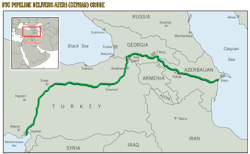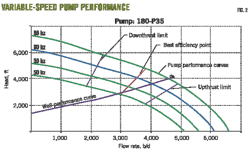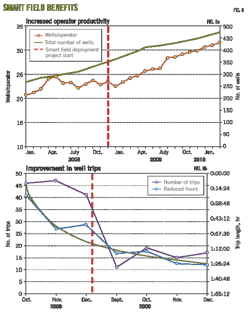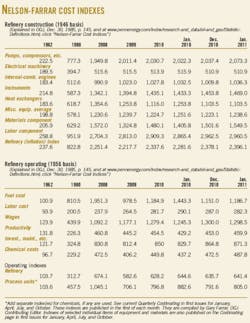The Uthmaniyah gas plant has achieved 100% additional service life of the gas molecular sieve desiccants.
This new record in gas desiccants service life was a result of modifications in the bed configuration and the regeneration process. Careful data monitoring and online sampling were also used to gain confidence to continue using the desiccant despite the vendor's recommendation of changing it.
This article will focus on the performance of the subject desiccant over the 7 years in the gas dehydrators at the gas plant, historical data and results, loading plan, and the factors helped in increasing the desiccant service life.
The Uthmaniyah gas plant uses a molecular sieve (desiccant) to remove water from sweet gas feeding the NGL-recovery area. NGL is recovered by cooling the sweet gas to a cryogenic –140° F. At this low temperature, no water is in the sweet gas. Otherwise, hydration will form blockage in the downstream equipment. The water content allowed to NGL recovery area is 10 ppm or less.
The molecular sieve material consists of zeolite and binders. The zeolite is the active material on which the water is adsorbed. Usually, the service life of the desiccant is 750 regeneration cycles, which is equal to almost 3 years at normal loading of gas. Uthmaniyah has successfully achieved 1,380 cycles (7 years) with no decline in the desiccant. This article discusses the factors in achieving this and the effects on the market.
NGL-recovery area
The Uthmaniyah gas plant has four identical NGL-recovery modules. The main objective of each module is to recover NGL from the sweetened gas through a cascaded refrigeration process that uses ethane and propane as refrigerants. Each module consists of three chill trains, which are basically a series of chillers and heat exchangers.
The sweet wet gas is fed to the module at 140° F. and 450 psig (Fig. 1). The gas is cooled at the first chill train to 65° F. After that, the feed is taken to a three-phase separator to remove liquid hydrocarbon and water from the feed gas.
The separated gas is saturated with water and fed to the gas dehydrators to remove moisture and avoid hydrate formation in the downstream equipment. At the same time the liquid hydrocarbon is sent to the liquid dehydrator to remove the moisture from it. The dry liquid hydrocarbon is sent to Tray 4 at the demethanizer. The dry gas leaves the dehydrators and continues to the second chill train where it is cooled to –35° F. At the end of the train the liquids are separated from the gas in a two-phase separator. The liquid hydrocarbon is sent to Tray 10 and the gas continues to the third train for further cooling.
The gas is cooled at the third chill train to –98° F. and the liquid is separated from the gas in a two-phase separator. The liquid is fed to Tray 19 and the gas is used to cool the feed in the upstream heat exchangers. The demethanizer stabilizes the NGL and removes the light ends. Then the product is drawn from the bottom of the column and sent to the shipping pumps.
Dehydration
The main objective of dehydration is to remove water from the gas:
- To meet sales-gas pipeline specification. This does not require deep dehydration. It can be achieved through glycol dehydration process. An example of this is Uthmaniyah and Shedgum gas plants' triethylene glycol units, where TEG is used to dehydrate the sweetened high-pressure gas and lower its water content to meet Saudi Aramco Standard A-120 of less than 7 lb/MMscfd water specification in the sales gas.
- To prevent hydrate formation under cryogenic conditions. This requires deep dehydration in which gas is dried up to 1-ppm water content.
Hydrate is an ice shape substance that forms under certain conditions in the presence of hydrocarbon mixed with free water. Hydrate formation depends on the pressure, temperature, and composition of the mixture. The temperatures at the Uthmaniyah liquid recovery units reach as low as –140 °F. This leaves no room to tolerate having undried gas.
At the Uthmaniyah gas plant, wet feed gas enters the dehydrators from the top and flows down the dehydrator where all the water in the gas is adsorbed and the gas leaves as dry gas from the bottom of the dehydrator (Fig. 2).
After some time, the gas dehydrator becomes saturated with water and regeneration of the dehydrator is required to remove the adsorbed water by the desiccant. The dry regeneration gas enters the dehydrator from the bottom to remove water and dry the desiccant. During normal operations, two dehydrators would be online and a third is under regeneration.
Desiccant performance
The first performance parameter is water adsorption capacity of the desiccant. The capacity started at about 19 lb H2O/100 lb of desiccant and stabilized after 400 regeneration cycles to around 10 lb H2O, which was above the minimum threshold of 8 lb H2O (Fig. 3). The minimum capacity the desiccant reached was 9.8 lb.
The second performance parameter is the pressure drop across the dehydrator. The pressure drop started at about 9 psi and gradually increased to a maximum of 13 psi, which was significantly below the maximum threshold of 25 psi.
Extending mol sieve life
Several factors helped extend desiccant service.
Special loading
The description of the loading plan will be from the bottom to top of the dehydrator (Fig. 5). Typically the dehydrator has 6 in. of supporting balls, between 0.5 in. and 0.25 in. in size. Support balls help hold the desiccant and avoid lifting it during the regeneration cycle.
At the same time, these balls even out distribution of the regeneration gas to the dehydrator. Support balls are inert; therefore, they do not have any water-adsorbing characteristics. After that, there is a 3-in. layer of desiccant sized of 2.5 mm to 5 mm. On top of it, there is a 60-in. layer of smaller size desiccant, 1.6 mm to 2.5 mm.
The fourth layer is the largest and has a height of 149 in. of large desiccant, 2.5 mm to 5 mm. On top of the molecular sieve, there is a 16-in. layer of activated aluminum.
It is believed that the activated alumina layer is one of the most important layers in the dehydrator as it acts as a sacrificial layer. This layer removes any contaminants in the gas and avoids poisoning the desiccant. Furthermore, because of its strength characteristics compared to the desiccant, it has higher resistance to the thermal degradation that takes place during the regen cycle.
Finally, there is a 6-in. layer of supporting balls. This layer evens out the distribution of the inlet wet gas and prevents desiccant migration during regeneration. This loading plan also reduces the pressure drop as the large desiccant is loaded at the top of the dehydrator.
Two-step regeneration
The regeneration process removes the water from the desiccant after it has been online for some time. After this process, the dehydrator is ready to receive the gas again.
In the past, the regeneration process occurred in one step and the regen inlet-gas temperature was heated to 500° F. (Fig. 6). In 1998, however, research conducted by the laboratory at the Research and Development Center at Saudi Aramco and work with the desiccant vendors indicated that the desiccant bed's service life could be extended if two stages of regeneration process were used.
In addition, several molecular sieve vendors recommended the two-stage regeneration in order to minimize the internal water-vapor condensation that occurs during the regeneration cycle.
The process calls for regenerating the desiccant in two stages. The first involves preheating the bed at a higher temperature, 250° F. for 90 min, while the second involves heating the bed at a higher temperature, 500° F. (Fig. 7).
The former drives off the adsorbed hydrocarbons before they coke and will prevent most of water from condensing. Water condensation causes sieve particles to breakdown and clog the desiccant bed leading to increased pressure drop across the gas dehydrators. The latter drives off the adsorbed water. Figs. 6 and 7 compare the two regeneration processes.
Risk taking, monitoring
The Uthmaniyah gas plant challenged the status quo for desiccant service life. Also, it has closely monitored the desiccant performance and went for risk taking in leaving the desiccant in the dehydrators.
The established recommended practice is that desiccant service life is around 3 years, which is almost equivalent to the vendor's warranty of 750 adsorption cycles. Extending the service life beyond that could result in unexpected failure, as reported by the vendor.
Although all of data indicated that the desiccant was very stable, there was no reason for not trusting the results and the confidence in the product. It was decided to keep it and at the same time increase the monitoring.
On line sampling
Finally, to reduce the risk associated with the decision to extend the service life for the desiccant, it was decided to take a sample from the desiccant and compare it to fresh desiccant. One dehydrator was isolated; a sample was taken and sent to the Research and Development Center at Dhahran for full integrity and adsorption analysis.
The results supported the conclusion. The desiccant was left for another 3 years, and the close monitoring for the desiccant was continued as well.
Market effects
Considering the current shortage in the desiccant market and the long lead-time—6 months—needed to receive a shipment, this experience has created the following effects:
- Improving desiccant quality by increasing competition among manufacturers. The competition to develop and optimize loading plans and manufacturing processes has become more intense than ever. The Uthmaniyah experience was shared with different vendors, who expressed amazement. Uthmaniyah informed vendors that the loading plan was a major contributor in extending desiccant life, and all vendors were trying to improve their loading plan to achieve a similarly long service life.
- Made more desiccant production available in the market. As the desiccant replacement period was extended, Uthmaniyah demand was cut by half. This made more desiccant available to the market and reduced the shortage





